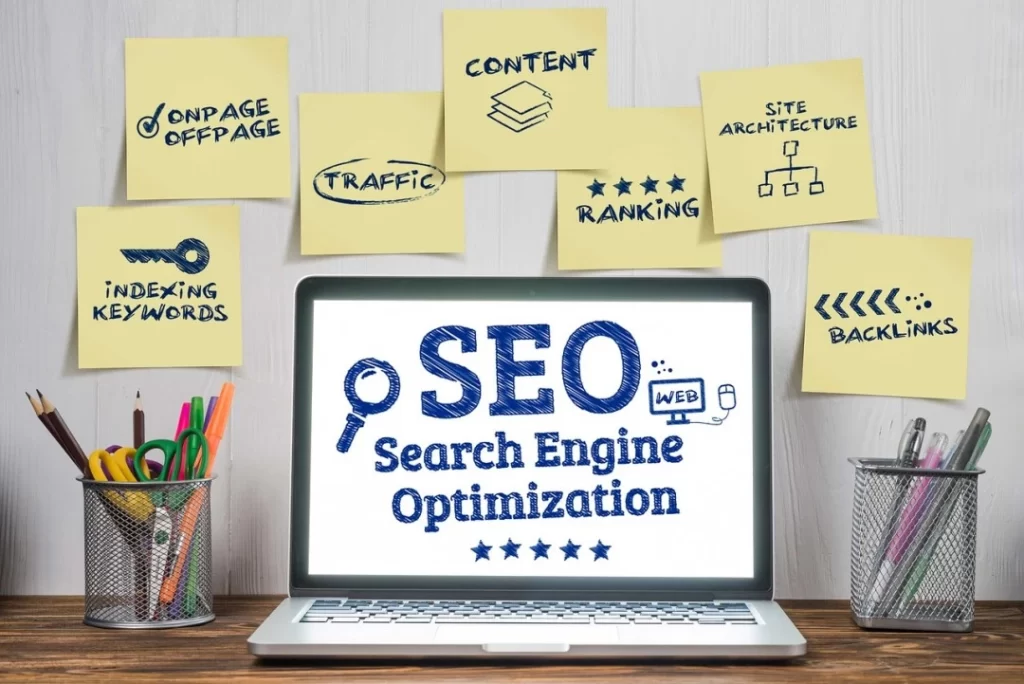
Great Search engine optimisation (SEO) is the foundation of online visibility, driving organic traffic to websites and helping businesses achieve their digital marketing goals.
Whether you’re an established business or a brand-new startup or entrepreneur, understanding and executing SEO according to best-practice is crucial to standing out in an increasingly crowded digital landscape. Unfortunately, many businesses make common SEO mistakes that can significantly hinder overall performance and all-important rankings on search engines like Google.
In this post, we’re going to delve into the top 10 SEO mistakes that can hurt your website’s search engine rankings, explain why they matter, and provide meaningful and easily actionable tips on how to fix them.
By avoiding these errors, you can improve your SEO strategy, boost your site’s visibility, and ultimately drive more traffic and conversions.
SEO Mistake 1: Ignoring on-page SEO factors
On-page SEO refers to all the elements within your website that you have control over to optimise for both search engines and users. These elements include title tags, meta descriptions, headings, URL structure, content, and images. Unlike off-page or backend SEO, which involves external factors such as backlinks, on-page SEO is entirely within your grasp and can be directly influenced to improve your site’s visibility – a huge win!
It’s important to realise that on-page SEO plays an all-important role in determining how well search engines (mainly Google) interpret your content. When optimised correctly, awesome on-page content helps search engines understand exactly what each page is about, which ultimately affects how Google ranks the page for the benefits of users. This is important because search engines use the content and structure of your web pages to assess their relevance to users’ searches.
Here’s an example. When a user or prospective client types a search query into Google, the search engine will try to match the query with the most relevant and authoritative content. The better optimised your on-page SEO factors are, the higher the chance your content has of ranking well for that user’s search.
The kicker? Poor website design, which we wrote about in a previous post, can really hurt your rankings.
Why is on-page SEO important?
Neglecting to optimise on-page factors can significantly impact your rankings – it’s a well-known fact. If you don’t work with an SEO expert like TopTrankings to utilise properly researched keywords, or if your title tags and meta descriptions are not clear and engaging, search engines might struggle to index your pages properly. The result? You’re at risk of much lower visibility and reduced organic traffic to your website.
How to fix your on-page SEO:
- Ensure that each page has a unique title tag and meta description, incorporating relevant keywords
- Use descriptive, keyword-rich headings and subheadings (H2, H3) to break up content and improve readability
- Structure your URLs with clear, descriptive keywords
- Ensure your content is well-written, relevant, and provides value to your audience
- Use internal links where appropriate to connect related content across your site
SEO Mistake 2: Overlooking mobile optimisation
In today’s digital landscape, mobile optimisation has become a critical factor for website success. With mobile traffic making up a significant portion of internet usage, it is more important than ever that websites are designed and structured to perform well on mobile devices. If your website isn’t optimised for mobile, you are likely to lose a substantial number of potential visitors, which can severely affect your search engine rankings and overall user engagement.
It’s widely acknowledged that mobile traffic, in general, has steadily increased over the past decade, and today, more people access the internet through mobile devices such as smartphones and tablets than through desktop computers – yes, you read correctly!. According to recent statistics, mobile traffic accounts for over half of global internet traffic, with this figure continuing to grow each year. This trend highlights the need for businesses to ensure their websites are fully functional on mobile devices to meet the demands of an increasingly mobile-first audience.
Google has also implemented a mobile-first indexing system, which means that the search engine primarily uses the mobile version of a website’s content for indexing and ranking. This means that if your site is not mobile-friendly, it can negatively impact your rankings in search results, as Google may not be able to properly crawl and understand your content. Mobile optimisation is no longer just a nice-to-have; it is now a necessity for maintaining visibility and competitive advantage in search engines.
Why is mobile optimisation important?
Google uses mobile-first indexing, which means it predominantly uses the mobile version of a website for ranking and indexing. If your site isn’t mobile-friendly, it can negatively affect your rankings, as well as user experience. A website that is difficult to navigate on mobile devices will drive users away, leading to higher bounce rates and lower conversion rates.
How to fix your mobile optimisation:
- Make sure your website is responsive, meaning it adapts to various screen sizes.
- Test your site using Google’s Mobile-Friendly Test tool to identify areas for improvement.
- Avoid pop-ups and interstitials that might obstruct the user experience on mobile devices.
SEO Mistake 3: Keyword stuffing
Keyword stuffing is the practice of overloading a page with keywords in what usually reads as a crude and unnatural way. The well-intentioned but poorly considered aim? An attempt to manipulate search engine rankings.
Why is it important to understand what keyword stuffing is?
While using relevant keywords is important for SEO, keyword stuffing can backfire. Google’s algorithms are designed to penalise pages that engage in this practice, as it negatively affects the readability and user experience. A keyword-stuffed page can often feel far from genuine and quite unnerving to read. As such, most users are far less likely to engage with it.
How to avoid keyword stuffing:
It’s really important to use keywords naturally throughout your content, including in titles, headers, and body text. Focus on keyword intent and relevance rather than aiming for high keyword frequency and use LSI (Latent Semantic Indexing) keywords and related terms to diversify your content and provide more context.
Better still, get in touch with our TopRankings team and organise a meeting with our copywriters who specialise in warm and skilled customer service, and SEO copywriting best practices: your key to great, naturally-reading SEO content!
SEO Mistake 4: Not using internal links
Internal linking refers to linking to other pages within your website. It’s a simple yet powerful way to improve the structure of your site and guide both users and search engines to your most important pages.
Why is using internal links important?
Without internal links, your website’s pages might be isolated, making it harder for search engines to crawl and index your content. This can result in missed opportunities for ranking certain pages. Additionally, internal links help users navigate your site and discover more of your content, improving user engagement.
How to make better use of internal links:
- Include internal links to relevant pages within your blog posts and content. Aim for a natural flow of links
- Use descriptive anchor text that clearly indicates what the linked page is about
- Ensure that your most important pages (like service pages or product categories) have enough internal links pointing to them
SEO MIstake 5: Failing to optimise for user intent
User intent refers to what users are looking for when they type a query into a search engine. Understanding the intent behind a user’s search is crucial for creating content that satisfies their needs.k;j[98y8
Why is it important to optimise your website for user intent?
If you create content that doesn’t align with what users are actually looking for, it’s unlikely to rank well. This can result in high bounce rates, as users quickly leave your site when they don’t find the information they need.
How to utilise user intent to inform your website design:
- Research the search intent behind the keywords you target. Are users looking for informational content, products, or services? The study of the meaning of words is called “Semantics” – look it up, and enjoy a deep-dive!
- Create content that directly answers the questions users are asking or solves the problems they face
- Use tools like Google Search Console to analyse search queries and optimise your content accordingly
SEO Mistake 6: Neglecting local SEO
Local SEO helps businesses appear in local search results, particularly for searches that include location-based keywords (e.g., “dentist in London”).
Why is SEO so important in web design?
Ignoring local SEO can make it harder for your business to appear in local search results, which is especially important for businesses with a physical presence. Without optimising for local SEO, you’re missing out on potential customers in your area.
How to fix your approach to SEO:
- Create and optimise your Google My Business (GMB) listing. Make sure all information (address, phone number, hours) is accurate.
- Encourage customers to leave reviews on your GMB page, and respond to those reviews to show engagement
Include local keywords in your content, title tags, and meta descriptions
SEO Mistake 7: Not monitoring SEO performance
Monitoring your website’s SEO performance is essential for identifying areas for improvement and tracking progress over time.
Why is it important to monitor your SEO performance?
Without tracking your SEO performance, you have no way of knowing whether your efforts are paying off. By regularly monitoring your rankings, traffic, and other key metrics, you can identify which strategies are working and where adjustments are needed.
How to monitor your website’s SEO performance:
- Use Google Analytics to learn about and monitor your website’s performance (don’t forget that Google Analytics can also help you gain valuable insight into user behaviour, just like what we explored in our recent blog!)
- Track metrics such as organic traffic, keyword rankings, bounce rate, and conversion rate to measure SEO success
- Work with an SEO expert like TopRankings to help you set goals and KPIs for your SEO efforts and regularly review them to ensure you’re on the right track
SEO Mistake 8: Using low-quality backlinks
Backlinks are one of the most important ranking factors in SEO, as they act as a vote of confidence for your website’s content. However, not all backlinks are created equal.
Why is it important to use quality backlinks?
Low-quality backlinks, especially those from spammy or irrelevant sites, can actually harm your rankings. Google’s algorithms are designed to penalise sites that engage in link schemes or acquire links from low-quality sources.
How to fix your backlinks:
- Focus on building high-quality backlinks from authoritative and relevant websites in your industry
- Avoid buying backlinks or participating in link farms, as these can lead to penalties
- Use backlink profile tools to disavow any harmful links – ask us how!
SEO Mistake 9: Not optimising for site speed
Site speed is a crucial factor for both user experience and SEO. Google considers page load time as a ranking factor, and users are more likely to leave a site that takes too long to load.
Why is optimising site speed so important?
A slow website not only frustrates users but also causes a higher bounce rate. Search engines, like Google, favour websites that load quickly, as they deliver a better user experience.
How to better approx the speed of your site:
- Compress images and other media files to reduce their size without compromising quality
- Use a content delivery network (CDN) to speed up your website’s load time
- Optimise your website’s code (HTML, CSS, JavaScript) to remove unnecessary elements and reduce load time
- Test your site speed using tools like Google PageSpeed Insights and make improvements where needed
SEO Mistake 10: Not regularly updating content
Outdated content can negatively impact your SEO efforts. Fresh, relevant, and updated content signals to search engines that your website is active and providing valuable information.
Why is regularly updating content so important?
Search engines prefer websites that consistently offer fresh content, as it provides value to users. If your content is outdated or irrelevant, you may lose your position in the search results.
How to approach content updates on your website:
- Regularly review and update your catalogue of blog posts, product descriptions, and landing pages to ensure they are accurate and relevant
- Add new sections, statistics, and insights to keep content fresh
- Contact our team to help you conduct a content audit on your website. We’ll help you consider the strategic content you might benefit from, focusing on new industry trends, challenges, or innovations, in order to help you maintain both influence and relevance
A final word from us on common SEO mistakes
Let’s be super clear: avoiding these common SEO mistakes can help you improve your website’s rankings and performance in search engine results pages. By ensuring your on-page SEO is optimised, your site is mobile-friendly, your content aligns with user intent, and you’re building quality backlinks, you’ll be well on your way to improving your search engine visibility.
SEO is a long-term strategy. While these mistakes can hurt your rankings, there’s no need to worry. Taking action to correct them will set you up for sustained success. Stay consistent, monitor your performance, and keep learning to stay ahead of SEO trends and changes in the digital marketing landscape.
If you’re unsure where to start or need help with optimising your website for SEO, our TopRankings team is here to help. Don’t forget that an experienced SEO agency, like our incredible team, can provide tailored solutions to boost your rankings and visibility.
Ready? Get in touch today!



